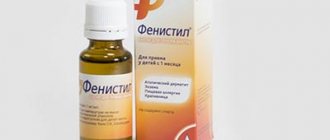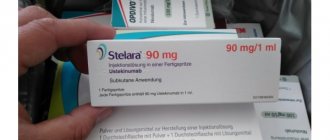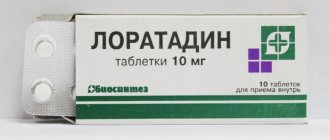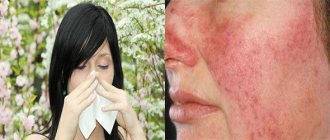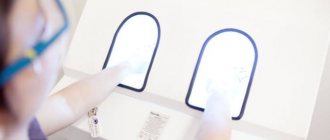The composition of Botox preparations and the effect of the components on the body
The main active component of Botox and similar products used in cosmetology is botulinum toxin type A. It is a poison of organic origin, but in minimal quantities, when injected under the skin, it causes relaxation - muscle relaxation.
That is, by blocking the passage of nerve impulses, it prevents the contraction of muscle fibers, and the skin in this area is smoothed out.
A number of people have increased susceptibility to even minimal amounts of botulinum toxin, which is manifested by muscle paralysis in the area of action of the drug.
However, this complication is not considered an allergy; there is no proven evidence that Botox-based drugs can cause a specific reaction in the immune system.
But allergies to Botox injections still happen and the reasons for its occurrence are the auxiliary components included in the products used for botulinum therapy in cosmetology.
These include:
- PROTEIN ALBUMIN (HUMAN). Contained in Botox, as well as Botulax and Relatox;
- LACTOSE AND ALBUMIN. They are components of the drug Dysport;
- SUGAROSE. Contained in Xeomin, Lantox, Refinex.

Albumin, lactose and sucrose can provoke the development of allergies in those people whose bodies are hypersensitive to them.
Typically, allergic reactions to Botox are not very pronounced in terms of symptoms and are easily tolerated. But allergies negatively affect the results of a cosmetic procedure and worsen your well-being.
Allergies are sometimes caused by improper dilution of botulinum toxin. Before injection, Botox preparations should be diluted with 0.9% sodium chloride according to the instructions. This is a physiological solution that is completely compatible with the internal environment of the body, it is well absorbed and does not cause changes in the functioning of the immune system.
However, some unqualified cosmetologists add lidocaine to Botox products in order to reduce pain sensitivity when giving injections.
This is a local anesthetic, to which allergies very often develop, and sometimes it occurs as anaphylactic shock or Quincke's edema, that is, severe reactions requiring emergency medical assistance.
An allergy to Botox can also be caused by the anesthetic cream that is applied to the face before the injections. It most often contains lidocaine or another painkiller.
That is, allergies to drugs containing Botox do happen. But the main reason for its development is auxiliary substances and anesthetics used to reduce pain during the session.
Composition of Dysport and indications for use
Expression wrinkles form on the forehead, cheeks, corners of the eyes and lips. This is due to the constant contraction of muscles: the more a person frowns, smiles or gets angry, the more clearly they are visible. At a young age, elastic skin is able to stretch and contract on its own , but over time it loses its elasticity and does not have time to get into shape.
Like Botox, Dysport is a neuroparalytic poison based on botulinum toxin or botulinum toxin. When it enters the muscles, it blocks the transmission of nerve impulses, the muscles stop contracting and relax, allowing the skin to smooth out. Over time, the substance is eliminated from the body and the course must be repeated again. The first time the result lasts for 4-6 months, then due to the accumulation effect it can reach 9-10 months. Judging by the reviews, after several procedures, two Dysport injections per year are sufficient.
Indications for the use of Dysport are:
- facial and age wrinkles located on the forehead, bridge of the nose, in the nose area, around the eyes and lips;
- folds on the neck and décolleté;
- cosmetological disorders: the presence of asymmetry in the location of the eyebrows, corners of the eyes and lips;
- increased sweating of the feet and palms;
- neurological diseases associated with increased muscle tone: blepharospasm, cerebral palsy, static torticollis and others.
The injections should be carried out by an experienced cosmetologist or attending physician , about whom there are positive reviews. It is prohibited to administer injections yourself.
Causes and methods of diagnosis
A professional cosmetologist who values his reputation will not give Botox injections immediately when a patient requests a service. First of all, the doctor determines the indications and contraindications for botulinum therapy, finds out whether there have been cases of allergic reactions in the past and to what, whether Botox was previously administered and how the body reacted to the drug.
A simple skin test, which can be performed in almost any cosmetology salon, helps to accurately determine the possible development of an allergy to products containing botulinum toxin:
- A small cut in the form of a scratch is made on the clean skin of the wrist. 2-3 drops of the Botox preparation chosen for the correction of wrinkles are dripped into it;
- Changes in the skin are assessed within an hour. With increased hypersensitivity, swelling and hyperemia, rash and itching appear at the injection site.

If an allergy is confirmed by a skin test, similar tests are carried out for other drugs with a neurotoxin. This makes it possible to understand exactly what irritant the body reacts to with hypersensitivity, which subsequently helps to select a harmless agent for botulinum therapy.
Testing for the possible occurrence of allergies when Botox is injected under the skin is not always considered a mandatory procedure, since there are not many real cases of an allergic reaction to botulinum toxin.
But this test must be carried out in cases where:
- There has been a history of hypersensitivity reactions to injectable drugs, especially anesthetics;
- The patient is prone to allergies of any type.
POPULAR WITH READERS: My story of fighting atopic dermatitis
Cosmetologists cannot refuse a test for sensitivity to Botox, and if the client himself wishes to conduct testing before the procedure. Therefore, for safety reasons and if you have doubts about the capabilities of your body, it is advisable to always undergo a sensitivity test before botulinum therapy; this will save you from many problems.
In addition, we should not forget that there are contraindications in which the administration of Botox even in minimal doses is not advisable.
These include:
- All trimesters of pregnancy and breastfeeding;
- Infectious diseases;
- Malignant processes in the body;
- The patient's age is under 18 years;
- Epilepsy and hemophilia;
- The period of treatment with antibiotics, sedatives, anticonvulsants and medications that affect the blood coagulation system. At least 2 weeks must pass from the last time you took these medications to the botulinum toxin injection procedure;
- Dermatitis.
With the above conditions and diseases, the functioning of the immune system deteriorates, hormonal levels and the course of metabolic reactions change, which can give rise to the occurrence of hypersensitivity.
Botox injections are not recommended for people over 45 years of age. The thing is that with age, muscles naturally relax and neurotoxin can worsen this condition, which negatively affects the cosmetic effect.
Symptoms
If you are intolerant to the components of drugs containing botulinum toxin, the allergy manifests itself both as local changes in the injection area and as general symptoms.
The following signs are characteristic of a local allergic reaction:
- Skin hyperemia at the site of Botox;
- Increasing swelling, sometimes painful;
- Temperature increase. Most often, hyperemia concerns the injection area, but it can also be general;
- Discomfortable sensations in the area of the eyes, lips, eyebrows, eyelids, that is, where Botox was injected;
- Problems with swallowing;
- Itching of the skin in the injection area, less often throughout the body;
- Dysarthria – deterioration in the pronunciation of sounds or individual words;
- Peeling of the skin.
The first manifestations of allergies usually begin 10-20 minutes after Botox injections. However, clear symptoms in most cases appear several hours and even days after the procedure.
The symptoms listed above do not always indicate an allergy. Swelling and redness are most often a consequence of injury to the epidermis and subcutaneous layers by an injection.
Deterioration in swallowing, pronunciation of sounds and changes in muscle activity can occur with increased absorption of botulinum toxin into the body. Therefore, it is impossible to independently determine whether there is an allergy or not. This should be done by a cosmetologist after examination.
Systemic allergic reactions to neurotoxin (anaphylaxis, angioedema) occur significantly less frequently compared to local allergies. But they are much more dangerous and the first symptoms can be noticed even at the stage of introducing Botox into the skin:
- The face begins to swell quickly;
- There is a strong lack of air;
- Trembling appears in the arms, legs and throughout the body;
- Heart rate increases;
- Sticky, cold sweat appears on the body;
- The pressure drops;
- Consciousness becomes stunned and inhibited.
In case of such manifestations of allergies, the procedure is stopped and the patient is given anti-shock drugs. After stabilizing his health, he should remain under the supervision of a medical professional for some time.
Botox: 10 side effects you didn't know about
Botox is botulinum toxin A, which is obtained from the anaerobic bacteria Clostridium botulinum. This nerve agent upon penetration causes paralysis of muscle tissue.
But it is believed that its concentration in the drug is so low that it does not cause significant harm to health. After the injection, the muscle and the skin above it completely relax: wrinkles are smoothed out, and new ones do not appear.
At least for the duration of the toxin's effect.
Injections are not always successful. For example, here is a selection of Hollywood stars who went overboard:
A new way to get rid of wrinkles and creases without the participation of a doctor is also popular - face fitness or facial massage. Why not try without the needle first? And if you're sure you want to pay a doctor for a botulinum toxin injection, read about the possible side effects.
Course by Elena Karkukli “Face fitness: perfect face in 10 minutes a day”
Facial asymmetry
There are no perfectly symmetrical faces in nature. Therefore, the muscles on one side of the face require more of the drug than the same muscles on the other. An insufficiently experienced cosmetologist may not take this into account and introduce the same dosage. And this will lead to a violation of proportions and the feeling that the face is slightly skewed.
Bruises and bruises
Injection needles are very thin. But they also injure the capillaries. So, at best, after the injections you will see small bluish dots, and at worst, extensive hematomas halfway across your face.
Complications are possible within 3-5 days after the procedure, and it is better not to make appointments during this time.
You can try to reduce the likelihood of bruising by taking a course of medications to strengthen the vascular walls.
Seals
Small bumps under the skin may appear if the drug is unevenly distributed. The reason is incorrect administration technique or insufficient dosage. For correction, a new dose of toxin is injected into the area with compactions a couple of weeks after the first procedure.
Ptosis
Sometimes, due to an overdose or uncontrolled spread of botulinum toxin from the injection site, drooping of the upper eyelid is observed. In some cases it is so serious that it is impossible to open your eyes! Don’t be alarmed: you just have to wait about 1-2 months, and the eyelid will return to its normal position.
Edema
In general, slight fluid retention is a normal reaction to injury. This swelling usually goes away within a few days. But sometimes changes in muscle tone lead to serious disruption of lymph flow and blood circulation. The result is widespread and persistent swelling. This complication may appear a week after the procedure.
Patients with cardiovascular diseases, hormonal imbalance, and renal failure are at risk. For prevention, try to limit your drinking of alcohol for at least a couple of weeks after the procedure. And you will have to sleep exclusively on your back.
You can try to eliminate swelling using lymphatic drainage self-massage techniques.
Acne
Many patients prone to acne note that after the administration of the toxin, this problem worsens.
Mobility problems
Sometimes a toxin introduced into the area around the lips causes complete paralysis of the facial expressions of this area. The lips look distorted, even speech is a little difficult. Many doctors, fearing such complications, prefer not to work with this area at all.
Headache
This is one of the most common side effects. It can appear immediately after the toxin is administered and lasts from several hours to two weeks. Reason: due to the paralysis of some muscles, others are overstrained, trying to maintain the usual facial actions. Symptoms can be relieved with analgesics.
Compensatory wrinkles
Attempts by neighboring muscles to “replace” immobilized ones also lead to changes in the direction of skin tension. This can lead to the appearance of new folds and wrinkles next to the ones we are struggling with.
Overdose
Hypercorrection or the “mask effect” may appear due to a doctor’s mistake who used a large dose of the drug, or due to the individual reaction of the body. Professional doctors try to administer the minimum dosage first, and after 2-3 weeks, if necessary, make additional injections.
Source: https://zen.yandex.ru/media/id/5beaa36cb69c3e00a98855ec/5c00e37447419c04b8097a4c
Treatment
If local symptoms of an allergy to Botox are mild, there is no need to worry too much. But it is important to make sure that this is really hypersensitivity and not another complication, so contact your cosmetologist for clarification.
An allergic reaction can be controlled by taking antihistamines in tablets, such as:
- Loratadine;
- Erius;
- Claritin;
- Peritol;
- Trexil;
- Other allergy medications.

With increasing swelling, it is better to take Suprastin. This drug quickly stops the development of allergies and prevents an increase in the symptoms of the pathology. After this, you should definitely consult a doctor.
With Quincke's edema and anaphylactic shock, the patient needs emergency care. If your health deteriorates in the clinic, the cosmetologist should:
- Apply ice to the injection site;
- Give antihistamines in injections - Suprastin, Diphenhydramine;
- In case of shock and a drop in blood pressure, inject Prednisolone or Dexamethasone into a vein;
- Provide fresh air flow.
In beauty salons that administer beauty injections there should be an emergency first aid kit. Using the medications included in it, an experienced doctor will always be able to provide immediate assistance if you are allergic to Botox.
If a cosmetologist cannot cope with the relief of anaphylaxis on his own, then he must call a resuscitation team to the clinic.
Prevention
The development of allergies after Botox injections is not uncommon, so it is better to prevent the development than to deal with it later. As a preventive measure, before the procedure you need to take care of the following:
- do not undergo the procedure if you are not feeling well;
- notify the doctor about the presence of diseases and medications;
- report a tendency to develop allergies;
- postpone injections if there is irritation or skin disease;
- Do not drink alcohol 3-4 days before the procedure.
Only a competent approach and qualified consultation will avoid the development of allergies. Correctly selected dosage by the doctor and compliance with the recommendations by the patient is the key to a favorable outcome of the procedure.
Preventive actions
The main therapeutic effects of botulinum toxin and drugs based on it have been well studied. But studies that would establish the frequency of development of allergies to neurotoxin have not yet been conducted.
POPULAR WITH READERS: Methods for treating vitamin D allergies
Therefore, when choosing a method for correcting wrinkles using Botox and its analogues, cosmetologists give recommendations only those that are determined based on practice:
- Individual hypersensitivity to the components of drugs containing botulinum toxin occurs extremely rarely, and even less often an allergy actually threatens health. Based on this, specific prevention of the development of an allergic reaction is not required for patients with no history of allergy;
- Before a botulinum therapy session, you need to make sure that there is no hypersensitivity to the anesthetic. You can ask the cosmetologist to use those types of anesthesia in which the conditionally dangerous Lidocaine is not used;
- In case of intolerance to Botox, recorded in the past, even if we are talking about minimal manifestations of allergies, further injections should be abandoned until the causative allergen is determined. You need to know that hypersensitivity increases over time - minor manifestations of an allergic reaction over time can turn into anaphylactic shock;
- The allergenic component can be determined by performing several skin tests. Having identified the allergen, you can already choose the safest product with botulinum toxin. For example, if you are lactose intolerant, you can use all medications except Dysport. If you are sensitive to albumin, you can use Xeomin or Lantox;

- The administration of Botox is completely abandoned if the allergy is a consequence of a specific immune reaction to botulinum toxin. In such cases, alternative methods help to cope with wrinkles on the face - fillers, hardware skin tightening.
Side effects from Botox
The use of Botox is the most common way to rejuvenate the skin, eliminate wrinkles and age-related defects. But some patients who use this method encounter a number of side effects, which should be reported to the specialist during the consultation.
[bsa_pro_ad_space id=3][bsa_pro_ad_space id=7]
Side effects of Botox, possible complications and their consequences
Most often, complications arise due to incorrect technique of performing the procedure, which does not correspond to the skin type or age of the patient. Most of the consequences are normal and go away on their own within a short period of time. But for some reasons, side effects can lead to significant defects and deterioration of the condition, which requires the help of a specialist.
The most common complications and side effects of Botox
The consequences can be divided into several groups:
- Local side effects of Botox caused by improper injection technique.
- General consequences provoked by the general effect of the drug on the body.
- The occurrence of defects after the procedure: asymmetry, ptosis, etc.
Consequences caused by incorrect technique, occurring in 2% of cases, include reactions such as itching at the injection site, redness, soreness, allergies, a feeling of tightness, dryness and swelling. Such consequences are the mildest and not dangerous to health; with proper care, they disappear within a few days.
The second group of consequences can manifest itself in the following reactions:
- muscle weakness;
- general malaise, headache;
- stomach upset, nausea;
- impaired sensitivity to temperature and touch;
- allergy;
- If the dosage is exceeded, difficulty swallowing and breathing may occur.
These body reactions occur when botulinum toxin enters the blood in an increased concentration, since normal doses are not capable of having a negative effect.
The third group of complications occurs for many reasons, including unqualified doctor and improper care. In order to avoid them, you need to become familiar with each manifestation.
Bruises and bruises: a normal reaction to injury
Even with a highly qualified doctor and compliance with all the rules for administering the drug, it is impossible to avoid the appearance of bruises and bruises. When treating the eyebrows, forehead and other areas, damage to the capillaries may occur, which will be reflected on the skin in the form of small pinpoint redness or, in the worst case, hematomas. This consequence is temporary, disappearing after 4-6 days.
Headache
This complication is common and occurs immediately after the procedure; headache can accompany up to several weeks. A common cause of headaches is the body’s reaction to trauma to the skin, as well as failure to follow the rules of post-procedure care, for example, drinking alcoholic beverages.
Also, headaches occur when facial asymmetry appears, which occurs when some muscles try to take over the functions of muscle fibers weakened by Botox, which leads to misalignment and pain in the head. The malaise persists until the functions of all muscles are restored and the fibers adapt to new loads, which usually goes away. within a few days.
Compensatory wrinkles and creases
After the procedure, a complication may arise such as the appearance of creases and folds in completely uncharacteristic places, which is due to the paralyzed muscles taking over the functions of neighboring ones, leading to a change in skin tension (formation of folds under the eyes or on the sides of the forehead when smiling).
The defect is corrected as follows:
- Smoothing of compensatory creases and folds occurs within several weeks after the muscles get used to the new loads.
- If there is no improvement, additional injections of botulinum toxin or hyaluronic acid will help correct the defect. Therefore, after the procedure, a competent doctor always schedules a repeat session for correction.
- But additional injections cannot always help and eliminate the defect, so the patient must wait until the end of the Botox effect, which is at least two months. Special products prescribed by a cosmetologist can speed up the process.
To avoid such a problem in the future, before the next procedure it is necessary to warn the doctor about the occurrence of this defect.
Overcorrection and overdose
The complication may be a consequence of the body’s reaction to the procedure or due to a violation of the doctor’s technique for administering the drug.
Some specialists, in order to avoid the mask effect, first inject a small dose of Botox, only then, after a few minutes, inject the remaining ones.
But there is another group of people who are insensitive to botulinum toxin, and it is unknown how the body will behave on a standard dose of the drug.
With excessive administration of the drug, muscle relaxation occurs, which leads to the inability to show one’s emotions, creating the impression of a mask. With such a defect there is no threat to health, but there is an aesthetic problem, since the face in this case does not look attractive. There are no ways to eliminate the defect; the patient can only wait for the Botox to wear off.
Lumps and seals
Due to individual characteristics, insufficient administration of the drug or incorrect procedure technique, uneven distribution of the drug occurs, which causes the appearance of lumps and bumps.
To correct problem areas, after 14-21 days the specialist prescribes a second session, during which he administers a small dosage of the drug.
To avoid this complication, the specialist must monitor the administration of the drug during the procedure, as well as massage for better distribution.
Ptosis: complete or partial
The entry of botulinum toxin into the functional muscles leads to complete or partial ptosis, in which the patient experiences sagging eyelids or the inability to open the eyes. There are several reasons for this complication:
- spread of the drug beyond the injection;
- Excessive dosage of Botox.
According to statistics, a complication occurs in 1% of patients; the previous appearance returns after a few months. In mild cases, ptosis affects only the eyebrows; due to their high elevation, additional folds and creases may form on the forehead.
In this case, an inexperienced doctor may make a mistake by injecting more drug, trying to smooth out the muscle fibers, as a result, after a few days the eyebrows droop. The eyelid remains open, but the patient's appearance has aesthetic problems.
Swelling and bags under the eyes
Injections injure the skin, to which the body reacts with fluid retention and, as a consequence, the appearance of edema, which is the norm.
But sometimes swelling can indicate more serious disorders caused by changes in muscle tone, for example, poor circulation or lymph flow. This complication develops a week after the session.
The risk group includes patients with renal failure, hormonal imbalances and cardiovascular diseases.
It was also noted that edema most often develops with frequent bending down or abuse of alcoholic beverages. You can get rid of swelling using various procedures aimed at increasing muscle tone (physiotherapy, lymphatic drainage). But it is worth considering that, together with swelling, the effect of the procedure is reduced.
Diplopia (double vision)
Double vision or diplopia occurs when botulinum toxin spreads along the orbicularis muscle, and the toxin paralyzes the lateral rectus muscle, causing squint and double vision.
The reason for this complication is not following the rules after the session, namely maintaining a vertical position for the first few hours, which will avoid spreading the drug to neighboring areas. But many patients neglect this point, which leads to diplopia or facial asymmetry.
The complications are temporary and as the effect of botulinum toxin decreases, the patient’s condition improves and vision is restored.
Problems with lip mobility
When correcting vertical wrinkles with Botox or when lifting the corners of the mouth in the perioral area, problems with lip mobility often arise, and the main cause of such a complication is an overdose of the drug. According to statistics, complications in the lower part of the face occur extremely rarely; specialists use a small dosage with subsequent correction.
Pimples on forehead after botox
After injections, some patients report increased acne. But the formation of acne and the use of botulinum toxin are in no way related, and are only a coincidence.
The main cause of acne exacerbation is hormonal imbalance, impaired sebum production or exfoliation of dead skin layers.
The effect of Botox occurs only on muscle fibers, without affecting the fat content and structure of the skin.
Other Possible Problems
In addition to the above complications, there are other side effects that arise from the administration of botulinum toxin:
- increased fatigue, poor health, muscle weakness;
- difficulty swallowing, weakness of the muscle fibers of the neck;
- keratitis, non-closure of eyelids, lacrimation and dry eyes;
- gastrointestinal disorders;
- cough, runny nose, fever;
- dizziness;
- nausea.
Such side effects are not dangerous to health, do not appear outwardly and go away on their own within 2-4 days.
Main prohibitions after Botox injection:
In order to avoid complications, after injections it is necessary to strictly adhere to the specialist’s recommendations, which include prohibitions for from several hours to 3 weeks. After the procedure it is prohibited:
- perform any physical activity;
- lean down and forward;
- heat the injection site;
- go to the bathhouse, sauna, solarium;
- be in the open rays of the sun;
- take hot baths;
- touch your face and perform self-massage;
- take medications without consulting a cosmetologist;
- for the first hours you cannot be in a horizontal position, lie on your back or side;
- carry out peelings;
- use cosmetics and decorative products for the first days;
- laser procedures;
- use of masks with acids;
- drink alcoholic beverages.
By ignoring the prohibitions, there is a high risk of developing serious complications (asymmetry, ptosis, difficulty breathing).
Source: https://kosmetiksiti.com/pobochnye-effekty-ot-botoksa/
Memo for the patient
An allergy to Botox and similar drugs is quite possible. In some cases, its development can be prevented, and when symptoms appear, they can be quickly relieved.
Before the procedure you must:
- Make sure your cosmetologist is highly qualified. An experienced doctor knows how to deal with allergic reactions, and his office has the necessary medications and tools;
- Set the expiration date for products containing botulinum toxin. You definitely need to study the composition of the drug; perhaps there was an unusual reaction to some of the components in the past. When in doubt, it is better to conduct a skin test;
- Clarify the method of diluting the neurotoxin. It is safest to mix the drug with saline. solution.
If you feel worse during a session, you should:
- Tell your doctor about any uncomfortable changes. The cosmetologist must interrupt the Botox administration, conduct an examination and diagnosis, and, if necessary, carry out treatment on the spot;
- Listen to the doctor's instructions. Panic leads to an intensification of the allergic reaction and prevents the doctor from choosing the right treatment tactics.
If you notice signs of an allergy to Botox at home:
- Get a face-to-face consultation with a doctor. If this is not possible in the near future, then you should report disturbing symptoms by phone, you can send a photo of your face;
- For minor allergy manifestations, you should take an antihistamine;
- If signs appear indicating the possible development of anaphylactic shock or Quincke's edema, you should immediately call an ambulance.
An allergy to Botox, especially a local one, is similar to complications that arise when the injection technique is violated, and may also be a consequence of the individual characteristics of the body.
In this regard, you should not engage in independent treatment. Only an experienced doctor can determine the main cause of the changes and, based on this, select adequate therapy.
